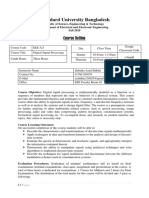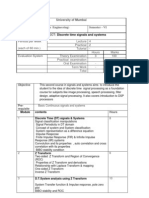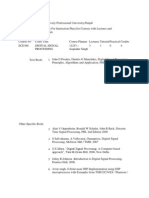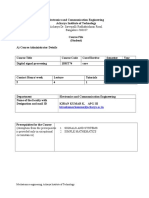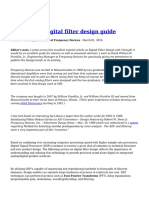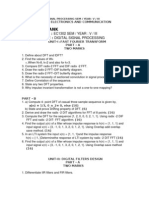Kkkl3184 Digital Signal Processing: and Applications, Fourth Edition, New Jersey: Pearson Prentice Hall
Uploaded by
Thiruselvan ManianKkkl3184 Digital Signal Processing: and Applications, Fourth Edition, New Jersey: Pearson Prentice Hall
Uploaded by
Thiruselvan ManianKKKL3184 DIGITAL SIGNAL PROCESSING
Course Objective
This course covers the basics of digital signal processing techniques. The objective is to enable the students to analyze discrete-time systems both in the time and the frequency domains.
Course Synopsis
This course starts with the classification of signals, the sampling theorem, analogue to digital and digital to analogue converters. Discrete-time signals and systems are analyzed and represented in terms of the difference equations and block diagrams. Analysis methods include using the time domain as well the z and Fourier domains. Linear timeinvariant systems are given particular emphasis where frequency and impulse responses, discrete and fast convolutions are covered. Design and analysis of Finite Impulse Response (FIR) and Infinite Impulse Response (IIR) filters are also covered.
Pre-requisite: KKKL2064 Circuits and Systems
References: Mitra, S.K, 2005. Digital Signal Processing, A Computer-Based Approach, Third Edition, New York: McGraw-Hill. Proakis, J.G. & Manolakis G., 2007. Digital Signal Processing, Principles, Algorithms and Applications, Fourth Edition, New Jersey: Pearson Prentice Hall. Salivahanan S., Vallavaraj A. & Gnanapriya C, 2001. Digital Signal Processing, New York: McGraw-Hill. Oppenheim, A.V & Willsky, A.S, 1997, Signals and Systems, New Jersey: Prentice Hall. Thomas, R.E. & Rosa, A.J. 1998, Analysis and Design of Linear Circuits, New Jersey: Prentice Hall.
LECTURE OUTLINE WEEK 1 2 3 4-5 6-7 8 9 10-11 12 13 14 TOPIC Introduction Classification of signals & sampling theorem Difference equation & block diagram representation Time domain analysis & convolution z-Transform Mid-semester break Review & Mid-semester exam Discrete Fourier Transform and Series FIR filters IIR filters Review
KL3063 DSP: Learning Outcome Matrix O O O O O O O O O O O O P P P P P P P P P P P P No. Course Outcomes Teaching 1 2 3 4 5 6 7 8 9 1 1 1 0 1 2 1 Ability to analyze discrete time 3 2 2 Classroom lecture, Tutorials signals in terms equations, sampling criterion, aliasing, digitization and quantization. (Analyzing) 2 Ability to analyze discrete-time 3 2 2 Classroom lecture, Tutorials signals and systems in the time domain (Analyzing) 3 Ability to analyze discrete-time 3 2 2 Classroom lecture, Tutorials signals and systems in the frequency domain (Analyzing) 4 Ability to analyze FIR and IIR 3 2 2 2 Classroom lecture, Tutorials digital filters (Analyzing) 5 Ability to synthesize FIR and IIR 2 2 2 2 Classroom lecture, Tutorials digital filters (Creating) 6 Ability to use MATLAB to 2 2 2 3 Classroom lecture and design, evaluate and synthesize problem based learning the performance discrete-time signals and systems including digital filters(Evaluating) 1 = Light emphasis to Programme Outcomes, 2 = Moderate emphasis 3 = Heavy emphasis Evaluation Project (PBL) 20 %-30% Assignments & Quizzes 10 % -20% Mid-semester exam 30 %-40% Final exam 40 %-50%
Assessment Examination
Examination
Examination
Examination Examination Written report
You might also like
- EE 438 Digital Signal Processing With ApplicationsNo ratings yetEE 438 Digital Signal Processing With Applications2 pages
- MTech SignalProcessingProposalRevision Final 20120427No ratings yetMTech SignalProcessingProposalRevision Final 2012042712 pages
- Ec 35514 Applied Digital Signal ProcessingNo ratings yetEc 35514 Applied Digital Signal Processing2 pages
- Course Information Sheet: Course Coordinator: Course ObjectivesNo ratings yetCourse Information Sheet: Course Coordinator: Course Objectives2 pages
- Ece2006 Digital-Signal-Processing Eth 1.0 37 Ece2006No ratings yetEce2006 Digital-Signal-Processing Eth 1.0 37 Ece20063 pages
- Introduction To Digital Signal ProcessingNo ratings yetIntroduction To Digital Signal Processing1 page
- Gujarat Technological University Mechatronics (47) : Mechatronics Signal Processing M.E. 2 SemesterNo ratings yetGujarat Technological University Mechatronics (47) : Mechatronics Signal Processing M.E. 2 Semester2 pages
- Course Syllabus: CSC747 - Digital Signal Processing: DescriptionNo ratings yetCourse Syllabus: CSC747 - Digital Signal Processing: Description2 pages
- Course Syllabus: CSC747 - Digital Signal Processing: DescriptionNo ratings yetCourse Syllabus: CSC747 - Digital Signal Processing: Description2 pages
- I.MTech_CSS255_Signals-n-Systems_Draft_V1No ratings yetI.MTech_CSS255_Signals-n-Systems_Draft_V13 pages
- Course Objective: Wollo University Kombolcha Institute of Technology Department of Electrical and Computer EngineeringNo ratings yetCourse Objective: Wollo University Kombolcha Institute of Technology Department of Electrical and Computer Engineering2 pages
- EE-413 Digital Signal Processing: Course OutcomeNo ratings yetEE-413 Digital Signal Processing: Course Outcome3 pages
- Microsoft Word - BE - ECE - 2017 - Scheme - Updated 3No ratings yetMicrosoft Word - BE - ECE - 2017 - Scheme - Updated 32 pages
- DR BAMU Me Etc Syllabus 18-June-13 FinalNo ratings yetDR BAMU Me Etc Syllabus 18-June-13 Final39 pages
- Digital Signal Processing (10MT74) Course File (Student)No ratings yetDigital Signal Processing (10MT74) Course File (Student)3 pages
- 03.09.2021 EEEB3024 - EEEB363 Course Outline Ver July 2021No ratings yet03.09.2021 EEEB3024 - EEEB363 Course Outline Ver July 202110 pages
- Advanced Signal Processing: Proceedings of The 21st Academic Council of VIT (30.11.2010)No ratings yetAdvanced Signal Processing: Proceedings of The 21st Academic Council of VIT (30.11.2010)2 pages
- Gujarat Technological University: W.E.F. AY 2018-19No ratings yetGujarat Technological University: W.E.F. AY 2018-193 pages
- Fc16asyllabus - Digital Signal Processing - TheoryNo ratings yetFc16asyllabus - Digital Signal Processing - Theory2 pages
- Digital and Kalman Filtering: An Introduction to Discrete-Time Filtering and Optimum Linear Estimation, Second EditionFrom EverandDigital and Kalman Filtering: An Introduction to Discrete-Time Filtering and Optimum Linear Estimation, Second EditionNo ratings yet
- Survey Power Quality Problems in TasmaniaNo ratings yetSurvey Power Quality Problems in Tasmania6 pages
- Signals: From Analog To Digital: KL3184 - Lecture2 1No ratings yetSignals: From Analog To Digital: KL3184 - Lecture2 127 pages
- The Effect of Coefficient Quantization On The Performance of A Digital FilterNo ratings yetThe Effect of Coefficient Quantization On The Performance of A Digital Filter17 pages
- Rajalakshmi Engineering College: Thandalam, Chennai - 602 105 Lesson PlanNo ratings yetRajalakshmi Engineering College: Thandalam, Chennai - 602 105 Lesson Plan6 pages
- Q.Explain Aliasing Concept With ExampleNo ratings yetQ.Explain Aliasing Concept With Example15 pages
- Design of IIR Filters: Difference Method, and The Bilinear Z-TransformNo ratings yetDesign of IIR Filters: Difference Method, and The Bilinear Z-Transform10 pages
- University of Mumbai B.E. Electronics EngineeringNo ratings yetUniversity of Mumbai B.E. Electronics Engineering2 pages
- Signal Processing Final Project Report On Multirate Signal ProcessingNo ratings yetSignal Processing Final Project Report On Multirate Signal Processing9 pages
- Question Bank: Subject Code: Subject NameNo ratings yetQuestion Bank: Subject Code: Subject Name5 pages
- DSP FAQ - Frequently Asked DSP Interview QuestionsNo ratings yetDSP FAQ - Frequently Asked DSP Interview Questions2 pages
- Design and Simulation of Radix-8 Booth Multiplier For Signed and Unsigned Numbers Using VHDLNo ratings yetDesign and Simulation of Radix-8 Booth Multiplier For Signed and Unsigned Numbers Using VHDL51 pages
- Lab 5. FIR & IIR Filters in MATLAB: Filter DesignNo ratings yetLab 5. FIR & IIR Filters in MATLAB: Filter Design12 pages
- Designing and FPGA Implementation of IIRNo ratings yetDesigning and FPGA Implementation of IIR6 pages
- Electronics & Communication EngineeringNo ratings yetElectronics & Communication Engineering242 pages
- Implementation of Discrete-Time SystemsNo ratings yetImplementation of Discrete-Time Systems45 pages
- Optimal Least-Squares Design of Sparse FIR Filters For Big-Data Signal ProcessingNo ratings yetOptimal Least-Squares Design of Sparse FIR Filters For Big-Data Signal Processing5 pages
- Design and Implementation of Optimized FIR Filter Using Reversible LogicNo ratings yetDesign and Implementation of Optimized FIR Filter Using Reversible Logic5 pages
- Smith Julius, Signal Processing Libraries For FaustNo ratings yetSmith Julius, Signal Processing Libraries For Faust9 pages
- EE 438 Digital Signal Processing With ApplicationsEE 438 Digital Signal Processing With Applications
- MTech SignalProcessingProposalRevision Final 20120427MTech SignalProcessingProposalRevision Final 20120427
- Course Information Sheet: Course Coordinator: Course ObjectivesCourse Information Sheet: Course Coordinator: Course Objectives
- Ece2006 Digital-Signal-Processing Eth 1.0 37 Ece2006Ece2006 Digital-Signal-Processing Eth 1.0 37 Ece2006
- Gujarat Technological University Mechatronics (47) : Mechatronics Signal Processing M.E. 2 SemesterGujarat Technological University Mechatronics (47) : Mechatronics Signal Processing M.E. 2 Semester
- Course Syllabus: CSC747 - Digital Signal Processing: DescriptionCourse Syllabus: CSC747 - Digital Signal Processing: Description
- Course Syllabus: CSC747 - Digital Signal Processing: DescriptionCourse Syllabus: CSC747 - Digital Signal Processing: Description
- Course Objective: Wollo University Kombolcha Institute of Technology Department of Electrical and Computer EngineeringCourse Objective: Wollo University Kombolcha Institute of Technology Department of Electrical and Computer Engineering
- Microsoft Word - BE - ECE - 2017 - Scheme - Updated 3Microsoft Word - BE - ECE - 2017 - Scheme - Updated 3
- Digital Signal Processing (10MT74) Course File (Student)Digital Signal Processing (10MT74) Course File (Student)
- 03.09.2021 EEEB3024 - EEEB363 Course Outline Ver July 202103.09.2021 EEEB3024 - EEEB363 Course Outline Ver July 2021
- Advanced Signal Processing: Proceedings of The 21st Academic Council of VIT (30.11.2010)Advanced Signal Processing: Proceedings of The 21st Academic Council of VIT (30.11.2010)
- Gujarat Technological University: W.E.F. AY 2018-19Gujarat Technological University: W.E.F. AY 2018-19
- Fc16asyllabus - Digital Signal Processing - TheoryFc16asyllabus - Digital Signal Processing - Theory
- Digital Filters Design for Signal and Image ProcessingFrom EverandDigital Filters Design for Signal and Image Processing
- Digital and Kalman Filtering: An Introduction to Discrete-Time Filtering and Optimum Linear Estimation, Second EditionFrom EverandDigital and Kalman Filtering: An Introduction to Discrete-Time Filtering and Optimum Linear Estimation, Second Edition
- Applied Digital Signal Processing and ApplicationsFrom EverandApplied Digital Signal Processing and Applications
- Computational Number Theory and Modern CryptographyFrom EverandComputational Number Theory and Modern Cryptography
- Signals: From Analog To Digital: KL3184 - Lecture2 1Signals: From Analog To Digital: KL3184 - Lecture2 1
- The Effect of Coefficient Quantization On The Performance of A Digital FilterThe Effect of Coefficient Quantization On The Performance of A Digital Filter
- Rajalakshmi Engineering College: Thandalam, Chennai - 602 105 Lesson PlanRajalakshmi Engineering College: Thandalam, Chennai - 602 105 Lesson Plan
- Design of IIR Filters: Difference Method, and The Bilinear Z-TransformDesign of IIR Filters: Difference Method, and The Bilinear Z-Transform
- Signal Processing Final Project Report On Multirate Signal ProcessingSignal Processing Final Project Report On Multirate Signal Processing
- DSP FAQ - Frequently Asked DSP Interview QuestionsDSP FAQ - Frequently Asked DSP Interview Questions
- Design and Simulation of Radix-8 Booth Multiplier For Signed and Unsigned Numbers Using VHDLDesign and Simulation of Radix-8 Booth Multiplier For Signed and Unsigned Numbers Using VHDL
- Optimal Least-Squares Design of Sparse FIR Filters For Big-Data Signal ProcessingOptimal Least-Squares Design of Sparse FIR Filters For Big-Data Signal Processing
- Design and Implementation of Optimized FIR Filter Using Reversible LogicDesign and Implementation of Optimized FIR Filter Using Reversible Logic
- Smith Julius, Signal Processing Libraries For FaustSmith Julius, Signal Processing Libraries For Faust
